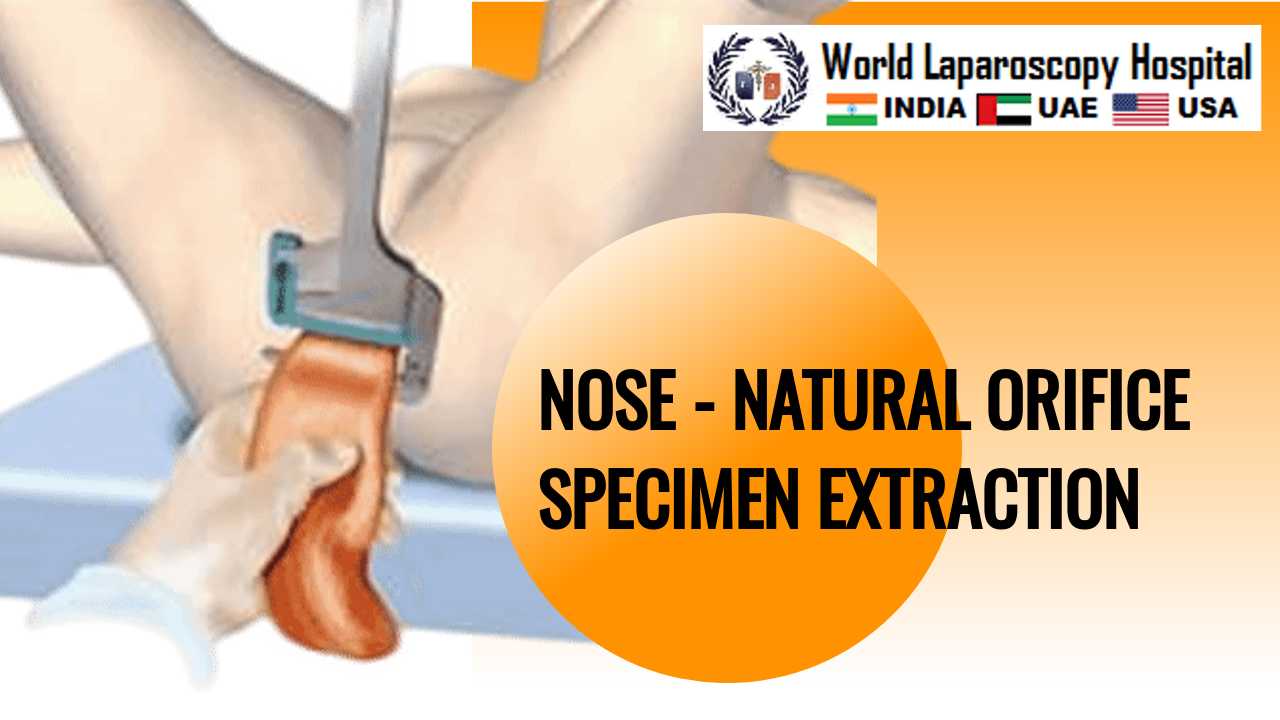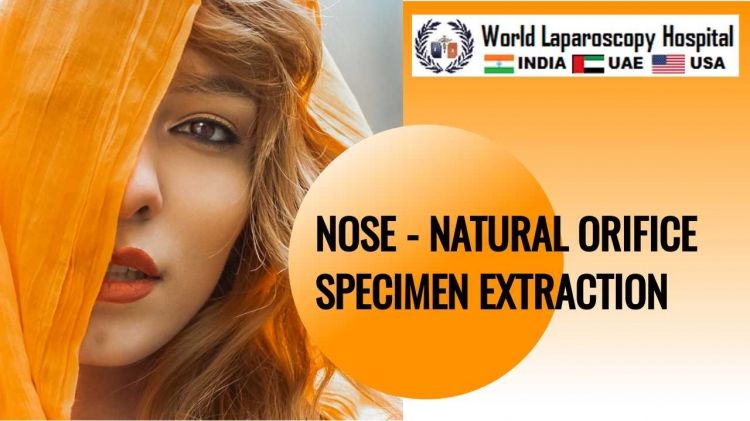NOSE - Extracción de muestras por orificios naturales
La extracción de muestras por orificio natural (NARIZ) es la apertura de una víscera hueca que ya se comunica con el mundo exterior, como la vagina o el tracto gastrointestinal distal, para extraer una muestra. Durante los últimos treinta años, el tratamiento quirúrgico de los intestinos ha evolucionado para consistir en técnicas médicas mínimamente invasivas. La cirugía mínimamente invasiva se asocia con una disminución del dolor posoperatorio, una disminución de los problemas de lesiones, un retorno más temprano de las características del tracto digestivo y un tamaño potencialmente mucho más corto de la instalación médica. En realidad, estos beneficios se han atribuido a una disminución en el trauma del personal en comparación con la cirugía abierta. La necesidad de extraer la muestra en procedimientos intestinales con una "minilaparotomía" puede anular la mayoría de los beneficios de los procedimientos quirúrgicos mínimamente invasivos.

The premise of this method is to decrease the injury needed to get rid of the specimen with the expectation that this may enhance end results. Reduction in postoperative analgesic usage, quicker return of bowel function, and shorter size of medical facility stay have been observed in colorectal operations with NOSE compared to standard specimen extraction. While the feasibility of NOSE has been shown in colon surgical treatment, failings of this method have actually additionally been described. The choice of people that can successfully undergo NOSE needs additional examination. Natural orifice sampling extraction (NOSE) eliminates removal website injury, which is or else always required. NOSE is defined as the elimination of a medical specimen by opening a hollow viscus that already connects with the outdoors, such as the anus or the vaginal area. As opposed to obtaining the specimen through an abdominal laceration, a viscerotomy is utilized for specimen extraction, which permits people to completely avoid the morbidity associated with larger abdominal cuts. The feasibility of NOSE in colon surgical treatment is well documented.
The option of NOSE by means of the vaginal area appears to be the most considerable element adding to greater NOSE success in ladies compared to men. It has been well developed that the flexible residential or commercial properties of the vagina allow the removal of even more bulky specimens when compared to proctotomies.
A barrier to wider adoption of NOSE is technological trouble. The mini-laparotomy, in some cases, is utilized to execute a majority of the operation, as in hand-assisted laparoscopy. Adoption of NOSE by cosmetic surgeons that usually perform colectomies in this fashion would certainly be faced with a steeper knowing curve than surgeons that make use of the mini-laparotomy solely as a specimen extraction site. On that note, intracorporeal anastomosis is a prerequisite ability for those adopting NOSE. Removal of more proximal specimens, as in an appropriate colectomy, needs the existence of a competent endoscopist that can arrest and also pull the sampling endoluminal through the size of the distal intestinal tract. Sampling extraction via the vaginal area needs a posterior colpotomy, an operative maneuver that is not generally performed by basic or intestines doctors. Additionally, these technical challenges are amplified by an absence of standardization of the technique.
The demands for these technological abilities are more vital in getting rid of right-sided colon pathology as contrasted to left-sided pathology. There are fundamental structural elements that make NOSE for right-sided colon pathology harder. Right colectomy specimens removed via the reduced stomach tract via distal colotomy must travel the length of the continuing to be transverse, descending, as well as sigmoid colon, with the anus and out of the anus utilizing an endoscope. While this was shown to be viable in 2010 by Eshuis, it is inherently tough due to the anatomically slim and torturous sigmoid colon. Because the collection, extraction through colotomy stopped working in 2 of 10 patients because of the mass of the sampling. This strategy is still performed in some centers, though restrictions associated with the dimension of the sampling are stricter than for left-sided colon sores. This approach has little practicality because of its substantial technical challenges, therefore its restricted use.
The vaginectomy, additionally called a colpotomy, is a secure technique typically employed by gynecologists and has been applied in NOSE for both gynecologic and also intestines pathologies. The first videotaped genital specimen removals in colon surgical treatment were in the 1990s. This strategy remains to be executed, particularly for right-sided colon pathology, offered the problem of using the distal colon for specimen removal.
Several research studies recommend some benefit to NOSE over laparoscopy with traditional stomach wall surface specimen extraction. Superior results in terms of postoperative discomfort control, time to very first digestive tract function, hospital length of keep, lowered incisional issues, as well as improved cosmesis, have actually been shown. It must be noted that research studies showing these remarkable results had stringent addition requirements. Mindful exam of patient characteristics in these research studies can be used to extrapolate themes that can help in picking individuals that can most gain from NOSE in intestines surgery.
Top

The premise of this method is to decrease the injury needed to get rid of the specimen with the expectation that this may enhance end results. Reduction in postoperative analgesic usage, quicker return of bowel function, and shorter size of medical facility stay have been observed in colorectal operations with NOSE compared to standard specimen extraction. While the feasibility of NOSE has been shown in colon surgical treatment, failings of this method have actually additionally been described. The choice of people that can successfully undergo NOSE needs additional examination. Natural orifice sampling extraction (NOSE) eliminates removal website injury, which is or else always required. NOSE is defined as the elimination of a medical specimen by opening a hollow viscus that already connects with the outdoors, such as the anus or the vaginal area. As opposed to obtaining the specimen through an abdominal laceration, a viscerotomy is utilized for specimen extraction, which permits people to completely avoid the morbidity associated with larger abdominal cuts. The feasibility of NOSE in colon surgical treatment is well documented.
The option of NOSE by means of the vaginal area appears to be the most considerable element adding to greater NOSE success in ladies compared to men. It has been well developed that the flexible residential or commercial properties of the vagina allow the removal of even more bulky specimens when compared to proctotomies.
A barrier to wider adoption of NOSE is technological trouble. The mini-laparotomy, in some cases, is utilized to execute a majority of the operation, as in hand-assisted laparoscopy. Adoption of NOSE by cosmetic surgeons that usually perform colectomies in this fashion would certainly be faced with a steeper knowing curve than surgeons that make use of the mini-laparotomy solely as a specimen extraction site. On that note, intracorporeal anastomosis is a prerequisite ability for those adopting NOSE. Removal of more proximal specimens, as in an appropriate colectomy, needs the existence of a competent endoscopist that can arrest and also pull the sampling endoluminal through the size of the distal intestinal tract. Sampling extraction via the vaginal area needs a posterior colpotomy, an operative maneuver that is not generally performed by basic or intestines doctors. Additionally, these technical challenges are amplified by an absence of standardization of the technique.
The demands for these technological abilities are more vital in getting rid of right-sided colon pathology as contrasted to left-sided pathology. There are fundamental structural elements that make NOSE for right-sided colon pathology harder. Right colectomy specimens removed via the reduced stomach tract via distal colotomy must travel the length of the continuing to be transverse, descending, as well as sigmoid colon, with the anus and out of the anus utilizing an endoscope. While this was shown to be viable in 2010 by Eshuis, it is inherently tough due to the anatomically slim and torturous sigmoid colon. Because the collection, extraction through colotomy stopped working in 2 of 10 patients because of the mass of the sampling. This strategy is still performed in some centers, though restrictions associated with the dimension of the sampling are stricter than for left-sided colon sores. This approach has little practicality because of its substantial technical challenges, therefore its restricted use.
The vaginectomy, additionally called a colpotomy, is a secure technique typically employed by gynecologists and has been applied in NOSE for both gynecologic and also intestines pathologies. The first videotaped genital specimen removals in colon surgical treatment were in the 1990s. This strategy remains to be executed, particularly for right-sided colon pathology, offered the problem of using the distal colon for specimen removal.
Several research studies recommend some benefit to NOSE over laparoscopy with traditional stomach wall surface specimen extraction. Superior results in terms of postoperative discomfort control, time to very first digestive tract function, hospital length of keep, lowered incisional issues, as well as improved cosmesis, have actually been shown. It must be noted that research studies showing these remarkable results had stringent addition requirements. Mindful exam of patient characteristics in these research studies can be used to extrapolate themes that can help in picking individuals that can most gain from NOSE in intestines surgery.



